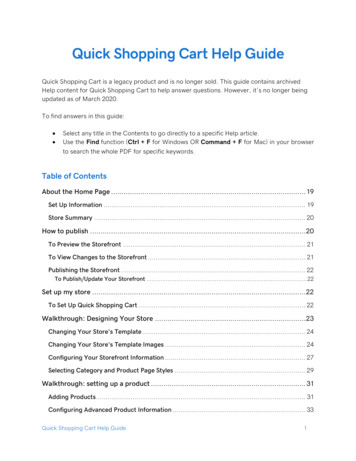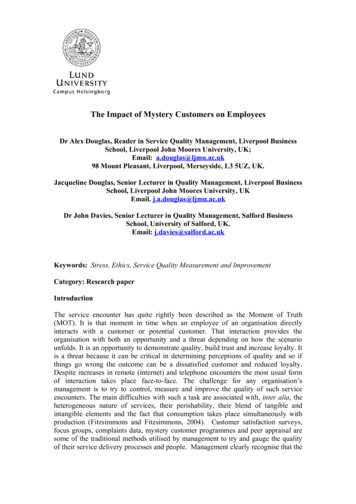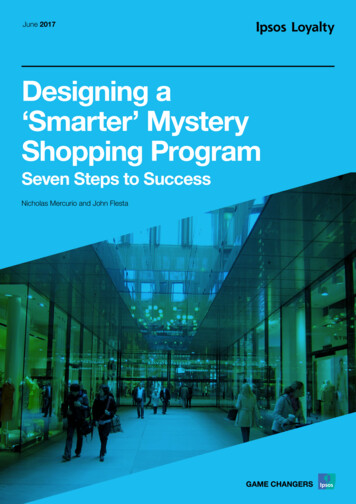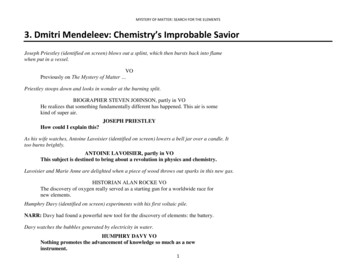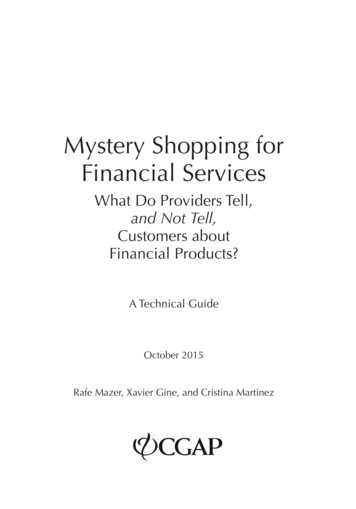
Transcription
Mystery Shopping forFinancial ServicesWhat Do Providers Tell,and Not Tell,Customers aboutFinancial Products?A Technical GuideOctober 2015Rafe Mazer, Xavier Gine, and Cristina Martinez
2015, Consultative Group to Assist the Poor (CGAP)1818 H Street NW, MSN P3-300Washington, DC 20433 USAInternet: www.cgap.orgEmail: cgap@worldbank.orgTelephone: 1 202 473 9594Rights and Permissions This work is available under the Creative Commons Attribution 3.0 Unported license (CC BY 3.0) http:// creativecommons .org/licenses/by/3.0. Under the Creative Commons Attribution license, you are free to copy, distribute, transmit, and adapt this work, includingfor commercial purposes, under the following conditions: Attribution—Cite the work as follows:CGAP. 2015. “Mystery Shopping for Financial Services: What Do Providers Tell, and Not Tell,Customers about Financial Products?” Technical Guide. Washington, D.C.: CGAP. License: Creative Commons Attribution CC BY 3.0 Translations—If you create a translation of this work, addthe following disclaimer along with the attribution: This translation was not created by CGAP andshould not be considered an official translation. CGAP shall not be liable for any content or errorin this translation. All queries on rights and licenses should be addressed to CGAP Publications,1818 H Street, NW, MSN P3-300, Washington, DC 20433 USA; e-mail: cgap@world bank.org.
Table of ContentsIntroduction1I.7Determining Policy Objectives of the Mystery Shopping ExerciseII. Selecting the Products and Delivery Channels to Include10III. Designing Consumer Profiles14IV. Training Shoppers and Conducting Mystery Shopping Visits18V.21Analyzing Mystery Shopping DataConclusion: Mystery Shopping and Consumer Protection Policy24References26AnnexesAnnex 1. Loan shopping visit questionnaire27Annex 2. Savings shopping visit questionnaire39Annex 3. Insurance mystery shopping questionnaire51Annex 4. Sample loan scripts for shopper profiles63Annex 5. Savings and fixed accounts shopper scripts69Annex 6. Life insurance shopper scripts81Annex 7. Provider survey on loan products87Annex 8. P rovider survey on deposit products91Annex 9. Informed consent form95Annex 10. O utcome variables used in analysis of savings andcredit shopping visits103iii
IntroductionWhen Alejandra (not her actual name) went to open a savings account at a bank branchin her hometown of Ecatepec, Mexico, she told the salesperson that she wanted an account for her daily financial needs that was easy to move money into and out of. Thesalesperson considered Alejandra’s expressed preferences and made a recommendationfor a current account. However, the salesperson failed to disclose the governmentmandated “total annual earnings” calculation on the account, nor mention that thisaccount carried with it monthly maintenance fees. The salesperson also failed to mention that there was another, cheaper option that would have fit Alejandra’s needs. Thiswas a “cuenta básica,” a no-frills savings account that is required to be on offer at allbanks in Mexico. Since Alejandra was a mystery shopper participating in research onsales practices, her experience helped to inform Mexico’s financial consumer protectionagency about the possible challenges in getting providers to disclose this low-cost savings option to the type of consumers that could most benefit from a simple, zero-costway to store and manage their savings.To expand responsible financial access and use, financial sector regulators and supervisors in many emerging market and developing economies (EMDEs) have expanded theirconsumer protection mandates, policies, and oversight in recent years. An essential elementof this expanding role for consumer protection policy is to be able to effectively monitorand understand what occurs during the sales process for financial products. Yet there areoften significant gaps between what is expected in consumer protection and market conductregulations, and what is done in practice by providers, which can render important policymeasures ineffective. This can lead to a worst-case scenario where the state of market conduct appears robust on paper—prompting a sense of complacency—yet in practice thesepolicies are not complied with, and abusive practices remain in the market, undetected bythe policy makers charged with financial consumer protection and often under-reported byconsumers. This lack of compliance with market conduct rules such as disclosure, financialadvice, and suitability requirements can be due to a number of factors: The sales staff is not properly trained The incentive to fully disclose terms or offer proper consumer advice is not alignedwith the business interests of the providers1
2Mystery Shopping for Financial Services Consumers or sales staff are in a rush to finalize the agreement The required disclosure rules and documents are too complex, lengthy, or difficult touse during a typical consumer-sales staff interactionPolicy makers are increasingly integrating consumer research methodologies tomonitor the market, gather insights, and inform policymaking.1 One effective consumerresearch method is mystery shopping, which measures the actual behavior of individualsales staff in a true sales environment. Mystery shopping is a tool that involves sendingconsumers to places of business, government agencies, or other service providers to simulate a typical customer inquiry.Mystery shopping is usually focused on a subset of products, provider types, andlocations, versus nationally representative surveys that measure consumer experienceacross an entire population sample. As such it is an indicative method that can be usedto signal issues in the market requiring further policy intervention or improved conductby providers. Used in this manner, mystery shopping is a useful tool to inform consumerprotection policy and measure market conduct issues such as how well sales staff comply with disclosure regulations, quality of customer attention and suitability of financialadvice, access to and use of recourse systems when things go wrong, and disparate treatment of vulnerable consumers.Recent mystery shopping assessments in several markets2 have provided policy makers with important insights on sales practices that can help inform consumer protectionpolicy:Limited presentation of mandated financial product information. Sales staff may notalways use the required forms and documentation during sales processes. Reasons for doing so may include to hide certain product information from the consumer, because theyfind the form overly complicated to explain and complete, or not relevant to their salesprocess. Irrespective of motivations, this is still a form on noncompliance with rules onsales practices, and it is important to document and understand this noncompliance tobetter align rules and common sales practices. Through this evidence policy makers canbegin to consider whether provider noncompliance should be more strictly monitoredand enforced, or whether policy approaches need to be changed to increase ease of implementation or to incentivize the desired conduct by providers.1A relevant example of this increased use of consumer research for market monitoring is the Reserve Bank ofMalawi’s 2014 Mystery Shopping on General Insurance Companies and Brokers, which used this tool to “assess general insurance service providers’ rate of transparency and disclosure of information when dealing withprospective policyholders of motor vehicle insurance The focus was determined by an increased number ofcustomer complaints the Register received from policyholders of motor vehicle insurance in the year 2013.”2Research was conducted in Colombia, Ghana, Kenya, Malaysia, Mexico, Peru, and the Philippines.
Introduction3Steering of consumers toward less suitable products. Suitability is a policy approachthat requires providers to be responsible for the quality of their advice and product offerings relative to a consumer’s characteristics and financial needs. In India and Mexico,sales staff were highly unlikely and unwilling to offer low-cost basic savings accountsmandated by the government, even when the consumers presented needs or product preferences that would recommend use of these basic savings accounts. In India, sales staffrequired unnecessary documents and made false statements about eligibility requirementsto prevent low-income consumers from acquiring a basic savings account (Mowl, Jensen,and Boudot 2014).Fraud and overcharging of consumers. In Kenya, banking agents skimmed extra revenue and took sensitive account information from aid program beneficiaries cashing outvia their debit cards, while food merchants added extra charges onto food items the beneficiaries purchased with their cards.3Different information for more experienced consumers. In Mexico, consumers presenting an “experienced” profile were given twice as much information about the costs ofthe financial products than those with “inexperienced” profiles (60 percent of total costsversus 30 percent of total costs) (Gine, Martinez, and Mazer 2014).As these cases demonstrate, abusive or uninformed sales practices can hinder access to financial products for base of the pyramid (BoP) consumers, create negativeexperiences with these products that decrease their likelihood to use financial productsand services in the future, and even cause detriment and economic loss to consumers.Therefore it is essential to both understand why sales practices do not always complywith regulatory requirements and develop policies that mitigate this misconduct bysales staff.This Technical Guide is designed to enable policy makers with jurisdiction overmarket conduct issues, consumer protection organizations, and development agencies toconduct mystery shopping exercises. The guide provides information on how to design,execute—either directly or by outsourcing to a research firm—and analyze mystery shopping exercises for financial services. This includes descriptions of the several stages ofimplementing a mystery shopping program: How to set the goals for mystery shopping based on what the policy maker seeks tomeasure (e.g., compliance with disclosure requirements, disparate treatment, qualityof advice), as well as the range of products providers seek to cover.3Results from a mystery shopping exercise conducted by CGAP and World Food Program Kenya, AugustNovember 2014. -cashless-food-aid
4Mystery Shopping for Financial Services How to recruit actual consumers and build shopping scripts that represent the populations and transaction types the policy maker is most interested in measuring.4 How to implement mystery shopping. This includes training shoppers, completingquestionnaires, and requesting complementary product information from providers. How to analyze the data to measure the quality and quantity of the financial information, sales staff advice, and disparate treatment of different consumer segments. Sample field guides such as shopper scripts, shopper questionnaires, product information request forms for financial institutions, and sales staff surveys.The guide and research tools presented are based on mystery shopping research conducted by CGAP, the World Bank, development agencies, and financial supervisors inseven markets with low-income consumers that included products such as savings, loan,insurance, and credit card products (Colombia, Ghana, Kenya [both for banking servicesand for digitization of food aid payment], Malaysia, Mexico, Peru, and the Philippines).The mystery shopping methodology used in these studies is characterized by several aspects, summarized here and described in more detail throughout this publication.Combined real and assumed consumer traits. The researchers in nearly all cases usedactual consumers recruited and then trained to conduct the mystery shopping. Actual consumers were selected to understand specific experiences of BoP consumers seeking financialproducts, and to measure how actual personal and financial details (such as credit bureauinformation and income levels) changed the types of products and guidance given to theseconsumers. (For loan products it is common for lenders to require home visits to confirmassets or collateral, making the use of local shoppers even more important.) These actualtraits were combined with several assumed needs, preferences, and experience levels thatconsumers were taught to portray. Examples of profiles consumers were trained to presentinclude level of financial knowledge and experience, amount of loan requested, and reasonfor seeking a life insurance policy, to name just a few. The use of these real and assumedprofiles allows the researchers to measure how sales staff treat different types of consumersand how well they match advice to consumers’ stated needs and preferences.Classification of the quality of information provided. Researchers identified the mostimportant product information and terms used in each market, as well as reviewed therelevant rules on product disclosure and sales practices. This is done to develop a comprehensive list of key terms that should be mentioned, and measure how many of these4Some mystery shopping use trained professional shoppers to conduct the shopping visits, instead of newlyrecruited consumers from the target population sample. The methods described herein use actual consumersto best understand the experiences of lower-income financial consumers and to measure provider responses toactual traits of these consumers, such as their previous borrowing experience, income level, and education.
Introduction5Box 1. Identifying expertise to execute mystery shopping exercisesFor newly formed consumer protection units within financial-sector regulators, designing and executing field research can create significant capacity burdens. As such,an important first step in conducting the mystery shopping techniques described inthis publication is to identify internal and external resources needed to carry out thefield work and subsequent analysis.The template questionnaires and field materials provided in the annex are intended to beadaptable to the particular product and research interests of a given consumer protectionunit. However, there is still need for experts in field research to recruit and train consumers, design and monitor the shopping visits, verify data, and analyze results. This will inalmost all cases require hiring a market research firm to handle at least some tasks.For analyzing the data, policy makers may have staff members with the requisite skills.As an example, in the Philippines the Financial Inclusion Unit of the Central Bank includes a team that tracks financial inclusion data and indicators. This staff was able toboth participate in the mystery shopping field work that was led by a market researchfirm—a key learning opportunity—as well as conduct all subsequent data analysis. Thiswas beneficial as both the analysis of findings and the interpretation of policy implications were handled by policy experts within the Central Bank. While capacity at thisstage may be limited in many consumer protection units, as financial inclusion and consumer protection units expand and mature, the amount of research design and analysisthat can be handled internally versus by a market research firm may increase over time.points of information were provided for each shopping visit. In addition, the researchersdeveloped categories for how the information was provided—written, verbally, explainedor merely mentioned, spontaneously or at the shopper’s request—to assess the depth andquality of the presentation of key terms.55There are, of course, challenges and limitations to the quantitative data measured via mystery shopping. Forexample, while shoppers can be instructed to obey general scripts and profiles, there is naturally going to besome personal variance in how individual shoppers portray the same profile. However, it is still possible toidentify indicative trends and patterns in sales practices and shopper experiences, which can indicate generalmarket conduct that can influence further research and policymaking. Personal variance around shopperprofiles can also be limited through proper preshopping training that includes the following: Role-playingof their assigned shopper profiles; scripts that provide sample phrases to mention upon introduction to thesales staff; piloting of shopping visits; and audio recording of each visit that is listened to by the enumeratorsand compared with the shopper profile and the questionnaire to ensure shoppers both generally obeyed theirprofile and reported information in the questionnaire accurately.
6Mystery Shopping for Financial ServicesCross-linking mystery shopping data with product databases. In several markets researchers complemented the mystery shopping visits with an audit of all possible products that could have been offered to the shoppers. This was done to accurately measurethe total number of terms and costs each product contains, and then compare this withthe number of terms provided by sales staff to shoppers and the total cost or return ofeach product.Sales staff surveys. Surveys of sales staff at financial institutions were added to several of the mystery shopping studies to understand their knowledge of financial productsas well as their salaries, commissions, and other incentive structures.This publication presents an overview of how to measure sales visits, quantify theirresults, and then analyze these findings to measure quality and quantity of information provided, product suitability, and sales staff behavior. The methods described hereinare designed to be effective both as a pre- and post-policy intervention tool, to provide information to inform different policy types—such as disclosure, suitability, andfair treatment—and offer information to monitor consumer protection policies’ impacton the market. Similarly, the consumer profiles, product features, and metrics have beendesigned to be adaptable to different product types, consumer segments, and deliverychannels, so that policy makers in each market can adapt them to their local context andpolicy needs. These methods have also proved to be easily replicable and cost-effectivemeans for gathering evidence for policymaking, meaning that it can be used by countriesacross the income spectrum and so can inform financial inclusion policy in a broad rangeof emerging markets.Figure 1. Stages of Mystery Shopping ImplementationI.Determiningpolicyobjec ves ofthe mysteryshoppingII. Selec ngthe productsand deliverychannelsIII. Designingconsumerprofiles fortheshoppingvisitsIV. Trainingshoppersandconduc ngmysteryshoppingvisitsV. Analyzingmysteryshoppingdata
I. Determining Policy Objectives of theMystery Shopping ExerciseMystery shopping can provide insights that serve a range of consumer protection andfinancial inclusion interests across the financial product lifecycle. While certain aspectsof setting up a mystery shopping exercise are fairly standard—such as measuring howinformation was provided and whether it was done spontaneously or on request—it isimportant to adapt the research to the primary policy goals. Some of the more commonconsumer protection policy goals for mystery shopping include the following.Understanding compliance with regulatory regimes. This includes rules on salespractices, fair treatment, suitability, and disclosure of product information. For example,credit shoppers in several markets were instructed to ask for explanation of the annualpercentage rate or total cost of credit, to measure its disclosure in sales visits and abilityof sales staff to explain its meaning and significance to consumers. Mystery shoppingcan also measure disparate treatment of certain consumer types (e.g., lower-income, lessknowledgeable) and provide evidence as to how well providers are complying with ruleson fair treatment.Measuring observed effect of recent regulatory reforms. This can be done througha two-phase mystery shopping conducted before and then shortly after a policy reformhas been implemented. In the Philippines, CGAP and the Central Bank of the Philippinesconducted credit shopping visits immediately before the implementation of the Truth inLending Act reforms in July 2012 and then a year later to measure changes in productdisclosure after the new Act was implemented in the market (see Box 2).Sales staff knowledge and selective disclosure of information. By including information gathered from shopper questions to sales staff, it is possible to measure how wellsales staff can explain key product terms. In addition, by assigning only certain shoppersto ask these questions, it is possible to measure how much sales staff share or withholdkey product information both when it is asked for by the consumer and when it is not.Product suitability. By using actual consumers with true-to-life variance in characteristics such as income and credit history, it is possible to measure provider responsiveness to certain personal or financial traits when making product offers. Similarly, byhaving consumers signal certain preferences—such as size of loan, level of risk tolerance,or planned use of a savings account—it is possible to measure how providers respond7
8Mystery Shopping for Financial ServicesBox 2. Measuring provider response to the Truth in Lending Reformsin the PhilippinesIn 2011 Bangko Sentral ng Pilipinas (BSP) revised the Truth in Lending Act(TILA) for credit products, including implementing a new suggested Loan Summary Sheet that had been consumer-tested. The reforms were an important stepin improving the information provided to potential borrowers and covered awide range of financial institutions. However, BSP wanted to assess the extentto which these reforms had impacted market conduct. CGAP and BSP designeda two-phase mystery shopping study to measure this impact in Metro Manila,Metro Cebu, and Metro Davao. They conducted two rounds of mystery shopping visits for loan products of 150 visits each. The first round of visits wasin June 2012—a month before the reforms took effect—and the follow-up inAugust 2013—more than a year after the reforms took effect. By comparing thepre- and post-data, BSP was able to understand where the reforms had more orless impact in product disclosure, including the following: A reduction in quoting of nominal interest rate—which is a less accurate reflection of the true cost of a credit product—from 81 percent to 69 percent,combined with an increase in quoting of effective interest rate (EIR) from 19percent to 31 percent. One of the key elements of TILA was a requirement tocite effective interest rates. This improvement in use of EIR was particularly thecase for lending-only institutions such as microfinance institutions and cooperatives. Another significant reform was a mandatory TILA poster on display at allbranches. Shoppers were asked to observe whether the poster was present duringtheir visits. Results varied greatly by provider type, with 82 percent of bank visitsnoting the poster on display, but only 20 percent or less for visits to other institution types. This may indicate the challenges of getting smaller provider types tocarry out such reforms and the need for follow-up engagement. There was also a decrease in information presented verbally and an increase ininformation provided spontaneously by sales staff in the 2013 visits. Written materials were also provided in 56 percent of post-TILA visits, up from 43 percentduring pre-TILA visits. However, for many key product features, such as totalcost and payment amount, disclosure of information pre- and post-TILA resultsvaried only slightly. So while TILA appears to have impacted disclosure of newcontinued
I. Determining Policy Objectives of the Mystery Shopping Exercise9terms it introduced such as EIR, changing disclosure practices for pre-existingrequired product terms may need additional efforts.Figure B2-1. Display of TILA Poster by Institution Type(by %, post implementation of TILA reforms)1009080706050403020100BankNGO MFILendingInstitutionCooperativePawnshopn Displayed n Not Displayedto these cues and compare treatment across different expressed personal preferences ofconsumers. In the Mexico mystery shopping, sales staff appeared to offer more suitable credit products for different consumer profiles than they did for savings products.Shoppers who requested a higher loan amount relative to their stated income level wereoffered a reduced loan amount more often than those who requested a loan amount thatwas smaller relative to their income level, as providers appear to have adjusted loan sizeoffered relative to each shopper’s capacity to pay. By contrast, savings shoppers interestedin low-balance transactional accounts were not provided information on the basic savings account that would offer the lowest-cost savings option suitable to their stated needs(Gine, Martinez, and Mazer 2014).
II. Selecting the Products and Delivery Channels to IncludeThe mystery shopping methods described in this Technical Guide have been applied acrossa range of products that include consumer credit, savings accounts, insurance products,credit cards, and mortgage products. They have also been tested through a variety of saleschannels, including bank branches, third-party agents and intermediaries, and financialadvisers. In determining which products to measure sales practices, policy makers shouldselect products where they have a strong need for additional knowledge on sales practices.This can be due to a range of factors, such as a new product or sales method enteringthe market, evidence from complaints data that a particular product is causing consumersproblems, interest in developing or modifying existing regulations around that product, orinitial insights from focus groups, consumer interviews, surveys, or other such demand-sideevidence on problems consumers have with that product.Depending on the product type(s) to be covered in the mystery shopping visit, severalaspects of the research design should be customized according to the local context offinancial service delivery and regulations.Relevant Regulations. A full review of all relevant regulations and other requirements should be conducted before developing the mystery shopping questionnaire todetermine the most important outcomes to measure to assess regulatory compliance.This includes rules regarding standard calculation of terms, physical and nonphysicaldisclosure of product information, and assessment of consumer needs and financial advice—often referred to as “product suitability” rules.Key Product Terms. This includes the different ways in which product cost or benefits are conveyed, as well as the most relevant features consumers should be informed offor this product. For a detailed list of product terms, refer to the annexes, which includeillustrative examples of questionnaires for credit, savings, and insurance products.Delivery Channels and Physical Location. New innovative delivery channels suchas mobile banking agents have expanded access and reduced costs of financial services.These delivery channels have also introduced new actors to the sales process. To measurethe impact a channel may have on the shopping experience, where possible, mysteryshopping should consider all the primary channels through which products are sold. Forexample, the CGAP and Bank Negara Malaysia mystery shopping inquiry into insurancesales considered three sales channels: bank branch, insurance agents, and financial advisers—which are not tied to a particular bank or insurance company. (See Box 3.)10
II. Selecting the Products and Delivery Channels to IncludeBox 3. Helping Food Aid Go Digital—Mystery Shopping with theWorld Food Programme in KenyaThe shift to digital payments can be an important cost-saving measure for organizations such as the World Food Programme Kenya (WFP), as well as a gateway tofinancial inclusion for beneficiaries who may not have had access to formal financialservices previously. However, this transition to digital also raises challenges for inexperienced consumers trying to navigate new products such as debit cards, mobile wallets,and sensitive account information such as PINs. To help monitor user experience andprotect them against risks, WFP and CGAP partnered to develop and pilot mysteryshopping methods to monitor two digital payment programs, with the goal of buildingan efficient approach that can be used by field teams for continuous monitoring acrossall of WFP’s digital payment programs. The first program, Cash Lite, replaced fooddistribution with cash transfers via debit cards that can be used at local merchants selling foodstuffs, who acquired point-of-sale (POS) devices from the participating bank.The second program, Cash for Assets, replaced cash payments for low-season workwith payments made via bank accounts linked to debit cards that could be used forcashing out, depositing, or transferring money at banks, ATMs, or banking agents.Both mystery shopping activities used actual WFP beneficiaries to conduct the transactions and were designed to reflect the particularities of each program. The keyfindings from the research include the following: In both cases, one of the primary points measured was whether private accountinformation was compromised during the merchant or agent transactions. In theCash Lite case, of the 46 shopping visits conducted, the merchant entered thebeneficiary’s PIN for them in 36 percent of the cases. In the Cash for Assets program, of the 73 shopping visits conducted, agents entered the PIN in 73 percentof visits, despite the fact that the researchers documented that 72 percent of thebeneficiaries who conducted these visits had memorized their PIN, and so shouldhave been all
Mystery shopping is usually focused on a subset of products, provider types, and locations, versus nationally representative surveys that measure consumer experience across an entire population sample. As such it is an indicative method that can be usedFile Size: 1MB

